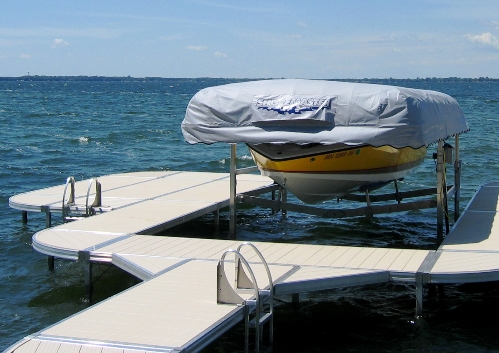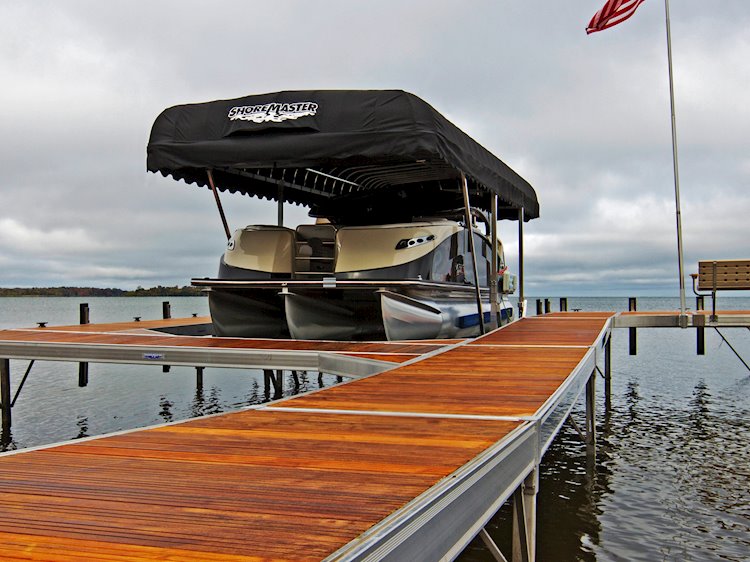Thanks so much. Jeanine J – Wisconsin
Thanks so much.
The pier placement was great this year and we enjoyed it!
Jeanine J – Wisconsin
Thanks so much.
The pier placement was great this year and we enjoyed it!
Jeanine J – Wisconsin
Hi Guys,
I trust you will put it in this spring. Remember the problem (brief drawing) you were able to correct it. Thanks for your help & assistance
George A. Door County

ShoreMaster’s Floating lifts (ShorePort) are excellent on rivers that fluctuate in depth, or marinas and inland lakes. They are very simple to use and need very little water to operate. The floating lift requires no maintenance, and you simply drive up onto it. No need to have a motor or crank a wheel.
The dock configuration is the next thing to consider when figuring your total dock cost. Your decision should be made after reading part one of this series (What does a Dock cost?). After reading that, you probably have an idea of the frame style you would like to use.
Next, you should read part 2 – What type of decking is available? Select the decking that caught your eye. Part three discusses the dock configurations you may want to use. We also include some of the accessories you’ll want to consider.
So you’ve measured water depths, surveyed the neighbor’s dock, and determined how far out you need to go. Maybe not! Don’t want to walk in the cold springtime water? Remember, we confirm the water depth for you as part of our site surveys.
At this point, you may be looking at a straight dock – (boring)!
What you add from here on transforms your dock from a strictly functional piece of equipment to a relaxing area, and so much more. The configuration you choose in the end should reflect the way you want to use the dock.
Everyone has different ways to use their dock. Some people want to be able to fish off the end of the pier. Maybe even have a bench or seating available. Others want access to their boat. Still, others will use their dock as a primary entertaining and relaxing area. These are all great reasons.
ShoreMaster docks are versatile so you can change your dock layout from season-to-season. Remember, the Infinity dock system allows you to do this easily. See also-https://wisconsinpws.com/infinity-track-system/
We have included configurations as well as actual photos of our docks in the photo array below. Get started on the layout that fits your needs. Then give Pier & Waterfront Solutions a call.
ShoreMaster has a simple dock-builder available online. Its very simple to use. (drag and drop) It handles MOST configurations. Are you having difficulty? We can do it for you. In most cases, we give you a rendition (sometimes hand-drawn), so you can be sure the layout is what you envisioned.
Docks are an excellent place for kids to learn from Grandpa. They can relax on the dock and exchange fishing stories and learn a little bit about life.
Try to extend the dock far enough into the water, so you’re next to a weed bed. A dock helps lure fish. Fish like to congregate and seek out cover and protection.
Sports – How about Kayak or paddleboard racks? Why keep carrying your equipment up to the house? Keep it handy and ready for use.
Entertaining – If you regularly party on your dock, you’ll want a dock that is wide enough to accommodate your guests. It must offer plenty of space for moving around. For extra space around a serving table or a bench, consider an additional 4-foot wide dock section. We can add it on to the standard 4-foot wide sections. Consider an inside corner section. It’s great for adding space – and peace of mind. A 90-degree corner can seem precarious.
For more pizazz, ShoreMaster offers a curved design on their truss and rail dock systems. Consider adding a curve to your dock. Go around obstacles like trees and rocks and make a unique dock at the same time. It definitely won’t look like your neighbors.
A rounded dock near the end, at the shoreline or even at the midpoint adds a unique design that only you have. The style is distinctly yours.
Ninety- five percent of the time the dock layout will include a “patio” area. The patio area requires a section of dock placed parallel or perpendicular to the main dock. Adding one patio dock essentially creates an 8 ft x 8 ft activity area over the water.
What if you add another patio area to the side to make a 12 ft wide x 8 ft long area? This additional “patio” section could be placed alongside the first section OR on the opposite side of the dock. The layout also helps protect your dock in a storm by making it broader and more stable. However, the REAL advantage of these layouts is that you have more working or entertaining area available.
Put a bench or patio set on the patio area to stay dry. Use it to get away from people entering or exiting the water – if they let you.
By the way, who said the patio section of a dock has to be at the far end of the pier? Would it be more functional at the midpoint or even at the shore end?
To summarize this series – What does a dock cost? It depends!
Missed a part of this series?
Part 1 – What does a Dock cost?
2 – What type of decking is available?
3 – Which dock configuration should I choose?
Do you have a friend that may be interested in this information? Please share a link to this page with them.
PWS is located at 7325 St. Hwy 57. That’s 1 mile North of County MM (Hwy 42) and 3 miles South of Sturgeon Bay at the Idlewild Road intersection.
Our staff is here year-round to assist you.

Dock decking is a critical choice. With all the decking choices – it’s the most important choice you make.
Frames for docks were covered in Part 1 of this series. Part 2 will cover the many choices of decking you have.
Wood decking was the first and only choice for decking. It required yearly cleaning. As simple as cleaning a deck may sound, it takes time each year.
The costs and inconvenience mount up.
In addition, a wood deck gets uncomfortably hot on sunny days. It also traps the dirt on its flat surface. This dirt needs to be washed off to prevent mold from forming. People started to look for other choices.
Then, along came a better choice!
Aluminum decking cuts down on maintenance. It solves the problem of painting or staining and sealing the wood. It only requires minimal washing to keep its appearance. No pressure washing or cleaners needed.
Plus, it does not get hot in the prolonged heat of the summer. The heat rapidly dissipates, so it stays cool to the touch.
There are many colors, and they look great.
Despite the advantages, aluminum does make noise when walked on. This issue is corrected by applying a cushion tape to the top of the frame.
Additionally, like wood, it comes in a “board” form. Why is that important?
Initially, plastic decking came in a board form. The board was bolted to the frame so it would not wash away. This worked great except the plastic shrinks and swells in the weather. It also gets dirty from rain and sand.
Most importantly, when the waves reached the decking, the 1/2″ opening between the boards was too small to relieve the pressure. This caused some docks (even heavy steel docks) to flip over.
People also mixed it with wood fibers which swelled over time. Still not a solution. Yet, plastic was a great idea, just not in a board form.
So what is the answer?
But not just any plastic. Flow-Through decking from ShoreMaster turned out to be the solution.
There are many reasons that plastic Flow-Through decking is the best choice including:
• It’s lightweight;
• Available in many colors and patterns;
• Eliminates the need to clean the decking;
• Can be mounted to the frame with a breakaway clip (recommended) or screwed down);
• It’s cool in the summer heat; and
• Most importantly, it has a 42% open surface which means 42% less pressure.
The open surface allows the water to pass through the decking. These openings relieve the pressure on the dock when a wave hits it. Solid boards do not do this.
In addition to eliminating the pressure of the water, it “self-drains” due to its curved surface. The decking does not allow moisture buildup on the panels. You have now removed one of (3) ingredients for mold and mildew to form. See related article: https://wisconsinpws.com/cleaning-wood-decking/
In conclusion, if you want the BEST decking for your money – look for Flow-Through decking from ShoreMaster at PIER & WATERFRONT SOLUTIONS.
For more information about additional types of decking follow this link: https://wisconsinpws.com/best-dock-decking/
At Pier and Waterfront Solutions, of course.
Part 1 – What does a Dock cost?
2 – What type of decking is available?
3 – Which dock configuration should I choose?
Do you have a friend that may be interested in this information? Please share a link to this page with them.
PWS is located at 7325 St. Hwy 57. That’s 1 mile North of County MM (Hwy 42) and 3 miles South of Sturgeon Bay at the Idlewild Road intersection.
Our staff is here year-round to assist you.